 Stennis Space Center, MS – NASA conducted a successful 500-second test firing of the J-2X rocket engine on Wednesday, November 9th, marking another important step in development of an upper stage for the heavy-lift Space Launch System (SLS).
Stennis Space Center, MS – NASA conducted a successful 500-second test firing of the J-2X rocket engine on Wednesday, November 9th, marking another important step in development of an upper stage for the heavy-lift Space Launch System (SLS).
SLS will carry the Orion spacecraft, its crew, cargo, equipment and science experiments to destinations in deep space. SLS will be safe, affordable and sustainable to continue America’s journey of discovery from the unique vantage point of space.
[youtube]http://www.youtube.com/watch?v=MjQ0j1a9RcA[/youtube]
“The J-2X engine is critical to the development of the Space Launch System,” Dan Dumbacher, NASA’s deputy associate administrator for exploration systems development, said after the test at NASA’s Stennis Space Center in Mississippi. “Today’s test means NASA is moving closer to developing the rocket it needs if humans are to explore beyond low-Earth orbit.”
Data from the test will be analyzed as operators prepare for additional engine firings. The J-2X and the RS-25D/E engines for the SLS core stage will be tested for flight certification at Stennis. Both engines use liquid hydrogen and liquid oxygen propellants. The core stage engines were developed originally for the space shuttle.
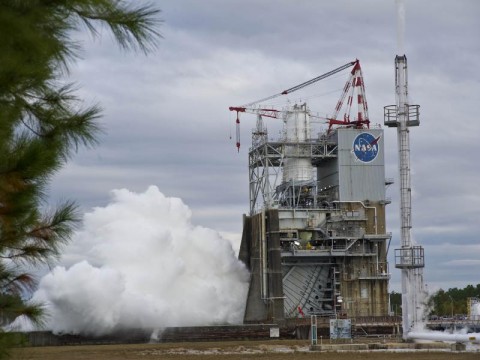
“The J-2X engine team and the SLS program as a whole are extremely happy that we accomplished a good, safe and successful test today,” said Mike Kynard, Space Launch System Engines Element Manager at NASA’s Marshall Space Flight Center in Huntsville, Ala. “This engine test firing gives us critical data to move forward in the engine’s development.”

“We look forward to adding to the legacy as we fulfill our responsibility to test engines that will power America’s next launch vehicle,” said Stennis Director Patrick Scheuermann.
Stennis has tested engines that carried Americans to space in both the Apollo and Space Shuttle programs. The J-2X engine is being developed for Marshall by Pratt & Whitney Rocketdyne of Canoga Park, CA.
For more information about NASA exploration, visit: http://www.nasa.gov/exploration
For information about NASA’s Space Launch System, visit: http://www.nasa.gov/sls
About the J-2X Engine
NASA’s New Upper Stage Engine
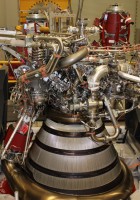
The next generation of space exploration has begun with the development of NASA’s Space Launch System, an advanced heavy-lift launch vehicle. As part of this endeavor, NASA is developing the J-2X rocket engine, a highly efficient and versatile rocket engine which will power the rocket’s upper stage. The Space Launch System will carry NASA’s Orion spacecraft, cargo, equipment and science experiments to space – providing a safe, affordable and sustainable means of reaching the moon, asteroids and other destinations in the solar system.
The J-2X engine design leverages 50 years of experience in human spaceflight with state-of-the-art technology in design processes, materials and manufacturing to enable further human exploration.
Capabilities
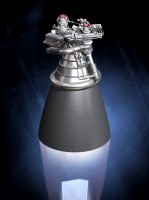
The J-2X is a liquid-oxygen/liquid-hydrogen fueled rocket engine that produces nearly 300,000 pounds of thrust in a vacuum. It is designed to start at altitude as part of a second or third stage of a large, multi-stage launch vehicle. In order to meet the requirements of specific mission profiles, the J-2X is designed to provide in-space restart and can operate at either the nominal throttle setting or at approximately 82 percent of nominal. The J-2X engine’s specific impulse– a measure of propulsive efficiency – is higher than any previous rocket engine in its class and of its type. It is equipped with a modern control and data system that is fully redundant and includes self-diagnostics to promote flight reliability and safety.
Background
Like every next generation, the J-2X leans heavily on previous generations for its essential makeup. This engine owes its name and point of departure to the flight-proven J-2 rocket engine of the Apollo era and the Saturn V launch vehicle that first took humans to the moon. The other historic predecessor was the experimental J-2S engine developed in the 1970s as a technology demonstrator.
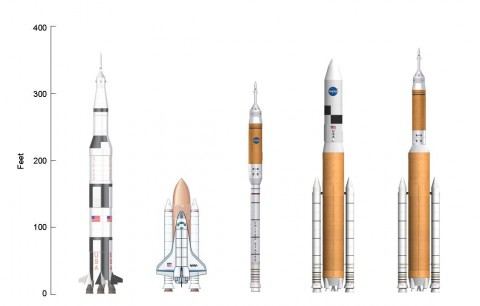
However, beyond these two legacy namesake engines, the J-2X is the beneficiary of the advancements of rocket engine technology in the areas of design, analysis, development and operations as demonstrated on the space shuttle main engine and the RS-68 engine used on the Delta IV launch vehicle. From these origins and from this accumulated knowledge base, under the auspices of modern design, construction and safety standards, the J-2X has taken shape.
Description
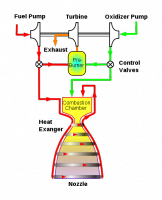
The J-2X uses a conventional gas-generator cycle – meaning that the turbomachinery is powered by a small, internal combustion chamber separate from the primary combustion chamber producing engine thrust. This is the same cycle that was used for the J-2 engine but the J-2X is at a power level elevated by approximately 25 percent. The J-2X turbomachinery used to pump the propellants through the engine can be traced to the J-2S engine, but with significant advancements in design, analysis and materials.
The gas generator combustor design can be traced to the RS-68 engine as can the designs for the main injector and the main combustion chamber. The nozzle consists of two parts: the upper (forward) portion is a hydrogencooled tube-wall construction while the lower, or aft portion consists of a nozzle extension nearly 8 feet in height and cooled by a combination of supersonic film coolant flow from the turbine discharge and passive radiation.
With its full nozzle extension installed, the J-2X measures over 15 feet tall and 10 feet in diameter at its base. It weighs approximately 5,400 pounds. Thus, its thrust-to-weight ratio is modest as compared to legacy systems but this is more than compensated by the higher specific impulse and a more robust, producible and affordable design.
Development
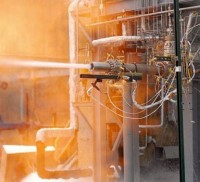
The development approach for J-2X was based upon the early identification of development risk, and the pursuit of risk mitigation through component and sub-component testing, and the application of robust design practices.
Early risk mitigation testing included subscale testing of the main injector; subscale and full-scale, of turbomachinery elements; characterization and margins testing of highly stressed turbomachinery airfoils; subscale testing of the nozzle contour, cooling schemes, and materials; and a long and instructive series of tests using a modular workhorse gas generator. Numerous engine components such as the engine controller, valves, valve actuators, and lines and ducts have undergone development testing as a natural consideration for flight qualification for these parts.
The J-2X Critical Design Review was conducted in fall 2008 and engine system testing began in summer 2011 with the first development engine E10001. Testing is being performed at NASA’s Stennis Space Center near Bay St. Louis, Miss., on the reconfigured test stands that have supported the Apollo and Space Shuttle Programs.
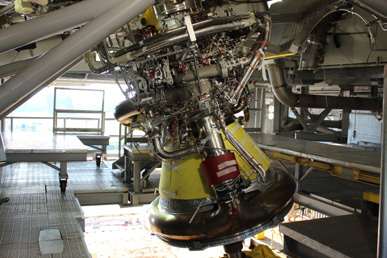
Engine full-power operations were achieved by the third test of the E10001 series demonstrating clearly the overall success of the risk mitigation activities leading to this point. Beyond E10001, there will be additional development engines, a full-scale turbomachinery test bed, and two flight certification engines demonstrating the final configuration to support space exploration operations.
The J-2X is designed and built by Pratt & Whitney Rocketdyne of Canoga Park, CA, for NASA’s Marshall Space Flight Center in Huntsville, AL.


